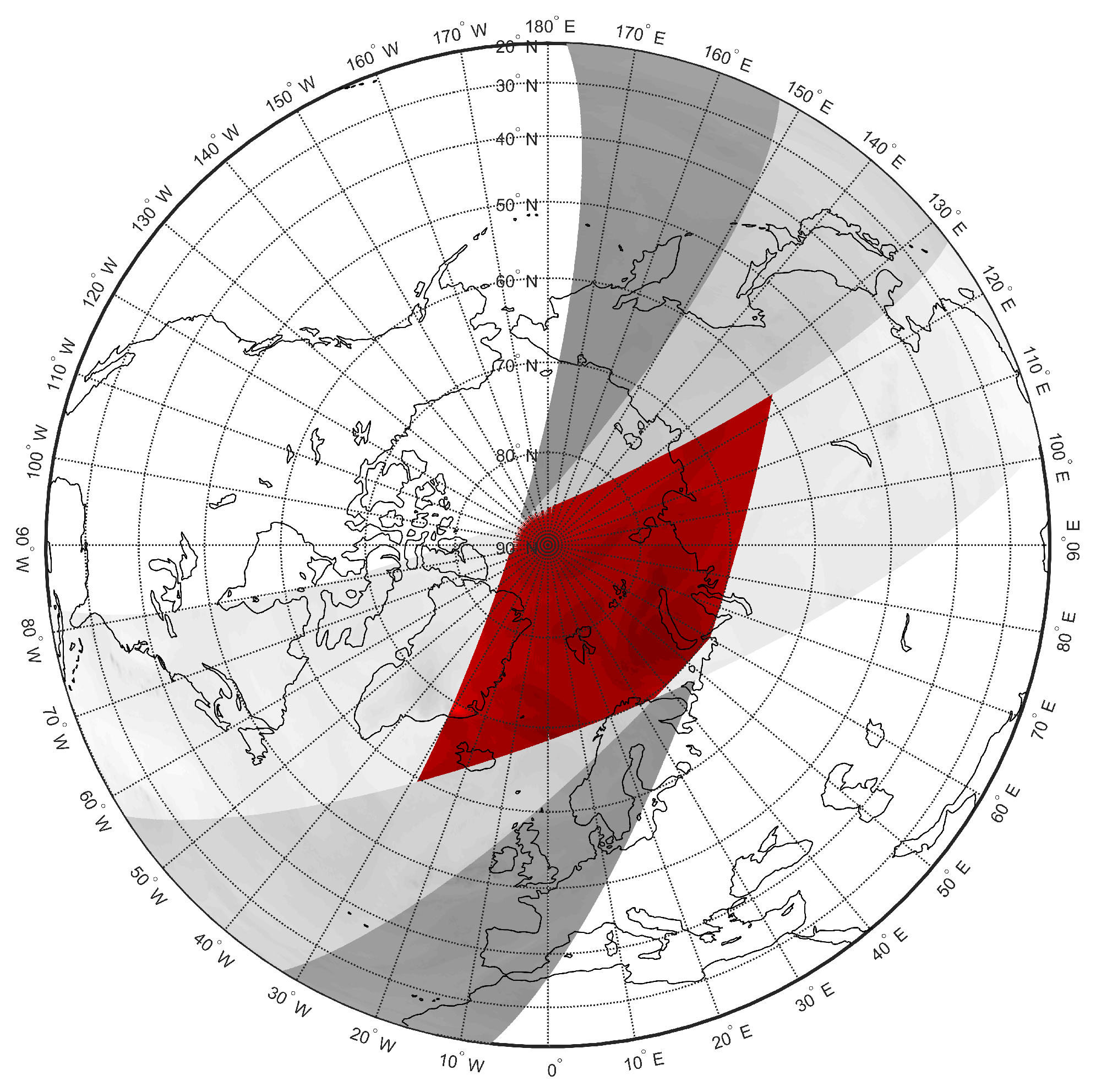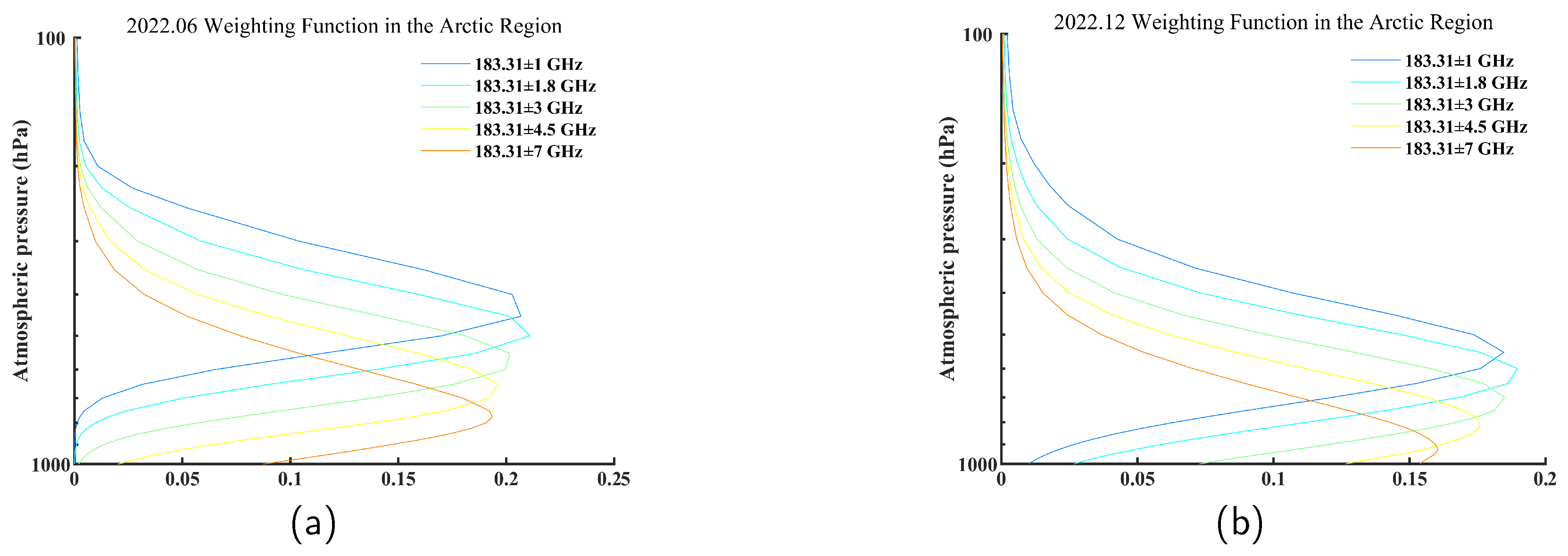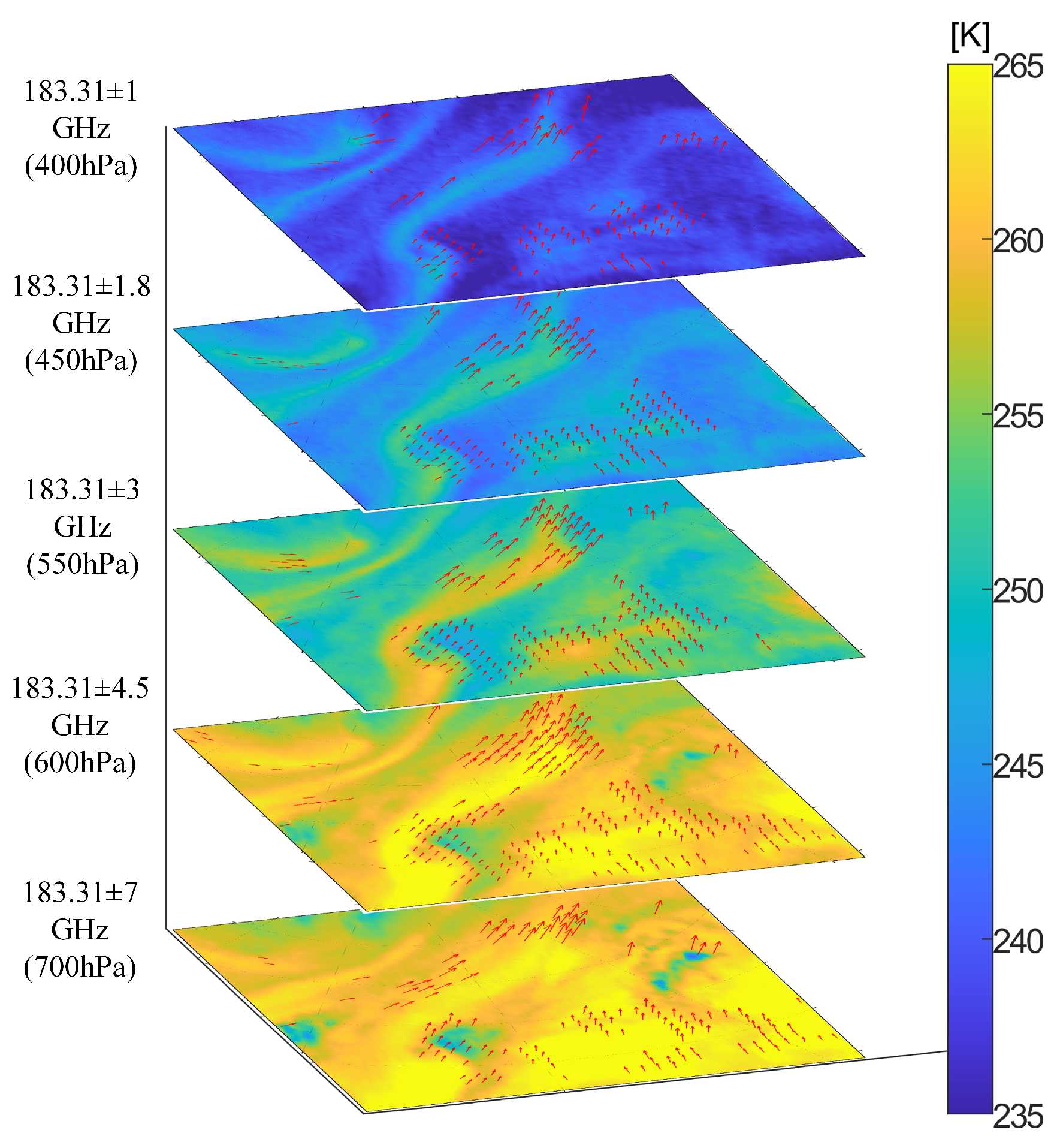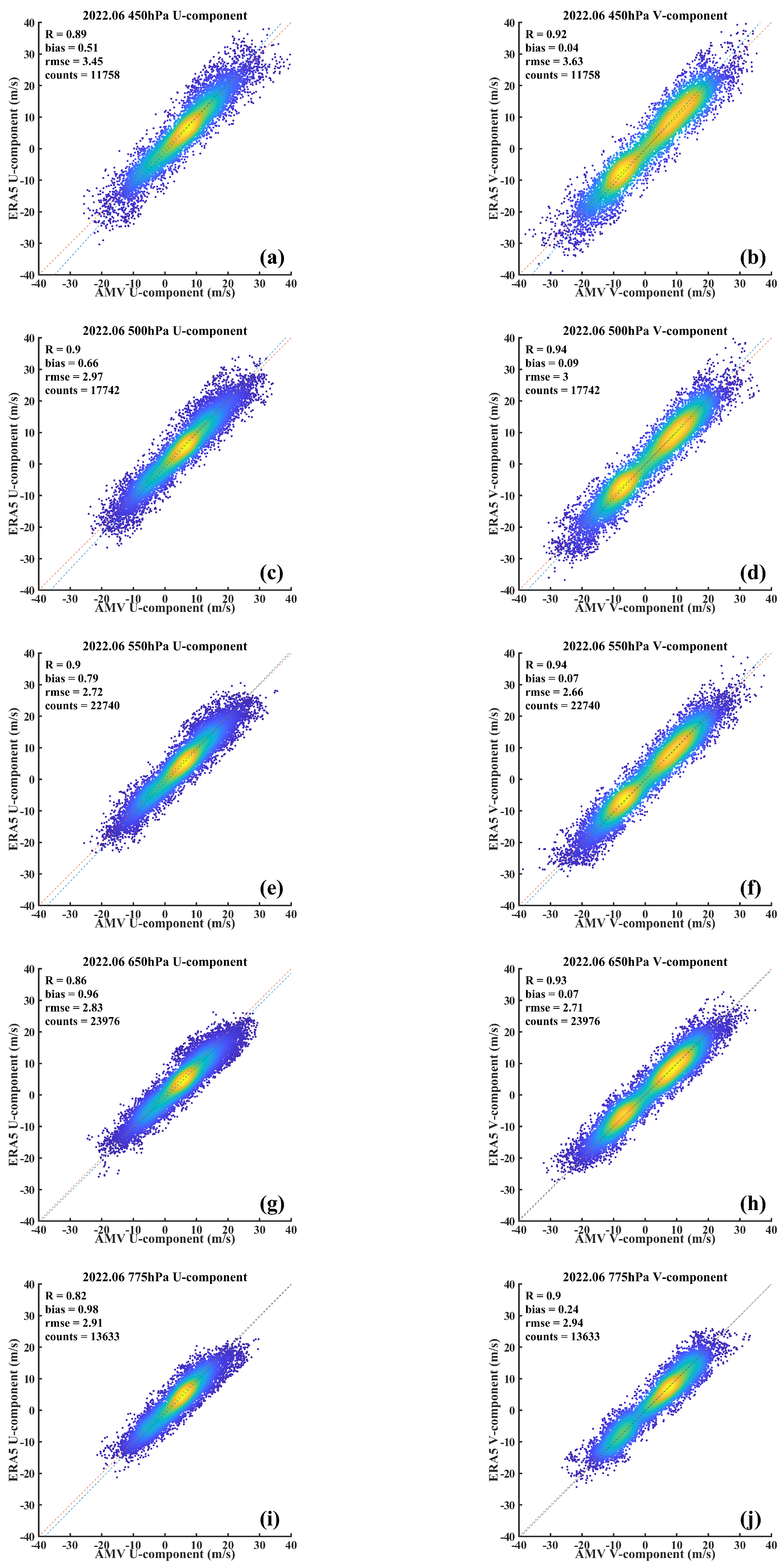Arctic Winds Retrieved from FY-3D Microwave Humidity Sounder-II 183.31 GHz Brightness Temperature Using Atmospheric Motion Vector Method
Abstract
1. Introduction
- The cloud dependence [13] for height assignment of AMV may be alleviated when using the five channels around the 183.31 GHz water-vapor absorption line.
- The temporal–spatial coverage of the polar wind record may be enriched by microwave radiometer data, especially considering that the Visible Infrared Imaging Radiometer Suite (VIIRS) lacks channels in either the infrared or the water-vapor absorption band for AMV derivation [14].
- Recent advancements in microwave radiometers aboard low-cost CubeSats constellations [15,16], as well as the concept of geostationary microwave sounders equipped with full-disk imaging capability via interferometric approaches [17,18,19,20], offer significant potential to facilitate the operational application of AMV-based wind records.
2. Materials and Methods
2.1. Data
2.2. Method Overview
2.3. Data Preprocessing
2.3.1. Parallax Correction
2.3.2. Remapping
2.3.3. Resampling
2.3.4. Overlapping Location
2.4. Target Selection
- Calculate the LSD of each pixel in the entire image within a 3 × 3 pixel area.
- Compute the cumulative distribution function of the LSD and determine the threshold at which the cumulative distribution function exceeds 0.9.
- Referencing EUMETAT’s target box size criteria [22] and through multiple experiments, the target box size was ultimately set to a size of 25 × 25 pixels. Within the target box, examine whether the local standard deviation of each pixel exceeds the threshold. If there are more than 5 pixels with a local standard deviation higher than the threshold, select that region as the target area.
2.5. Wind Tracking
2.6. Height Assignment
2.7. Quality Control
3. Results and Discussion
3.1. Seasonal Evaluation Using ERA5 Reanalysis Data
3.2. Comparison with NOAA VIIRS Polar Winds Record
- Benefiting from cloud penetration capability, more wind vectors are retrieved at lower height levels, which forms an effective supplements to the existing cloud-dependent wind records.
- Quality metrics at lower height levels are comparable to the state-of-the-art VIIRS wind record, although upper height levels exhibit some deterioration, demonstrating an overall good retrieval quality. The residual speed bias and direction bias may be attributed to the inferior spatial resolution, and require further investigation.
4. Conclusions
Author Contributions
Funding
Data Availability Statement
Conflicts of Interest
References
- National Research Council. Earth Science and Applications from Space: National Imperatives for the Next Decade and Beyond; The National Academies Press: Washington, DC, USA, 2007. [Google Scholar]
- Zeng, X.; Ackerman, S.; Ferraro, R.D.; Lee, T.J.; Murray, J.J.; Pawson, S.; Reynolds, C.; Teixeira, J. Challenges and opportunities in NASA weather research. Bull. Am. Meteorol. Soc. 2016, 97, ES137–ES140. [Google Scholar] [CrossRef]
- Schmetz, J.; Holmlund, K.; Hoffman, J.; Strauss, B.; Mason, B.; Gaertner, V.; Koch, A.; Van De Berg, L. Operational cloud-motion winds from Meteosat infrared images. J. Appl. Meteorol. Climatol. 1993, 32, 1206–1225. [Google Scholar] [CrossRef]
- Forsythe, M.; Peubey, C.; Lupu, C.; Cotton, J. Assimilation of wind information from radiances: AMVs and 4D-Var tracing. In Proceedings of the ECMWF Annual Seminar, Grande Prairie, AB, Canada, 8–12 September 2014. [Google Scholar]
- Izawa, T.; Fujita, T. Relationship between Winds and Cloud Velocities Determined from Pictures Obtained by the ESSA 3, ESSA 5 and AST-I Satellites; North-Hol land Publishing Co., Space Research IX: Amsterdam, The Netherlands, 1969; pp. 571–579. [Google Scholar]
- Fujita, T.T. Principle of stereoscopic height computations and their applications to stratospheric cirrus over severe thunderstorms. J. Meteorol. Soc. Jpn. Ser. II 1982, 60, 355–368. [Google Scholar] [CrossRef]
- Menzel, W.P. Cloud tracking with satellite imagery: From the pioneering work of Ted Fujita to the present. Bull. Am. Meteorol. Soc. 2001, 82, 33–48. [Google Scholar] [CrossRef]
- Nieman, S.J.; Menzei, W.P.; Hayden, C.M.; Gray, D.; Wanzong, S.T.; Velden, C.S.; Daniels, J. Fully automated cloud-drift winds in NESDIS operations. Bull. Am. Meteorol. Soc. 1997, 78, 1121–1134. [Google Scholar] [CrossRef]
- Bresky, W.C.; Daniels, J.M.; Bailey, A.A.; Wanzong, S.T. New methods toward minimizing the slow speed bias associated with atmospheric motion vectors. J. Appl. Meteorol. Climatol. 2012, 51, 2137–2151. [Google Scholar] [CrossRef]
- Herman, L. High frequency satellite cloud motion at high latitudes. In Proceedings of the Symposium on Meteorological Observations and Instrumentation, Anaheim, CA, USA, 17–22 January 1993; pp. 465–468. [Google Scholar]
- Key, J.R.; Santek, D.; Velden, C.S.; Bormann, N.; Thepaut, J.N.; Riishojgaard, L.P.; Zhu, Y.; Menzel, W.P. Cloud-drift and water vapor winds in the polar regions from MODIS. IEEE Trans. Geosci. Remote Sens. 2003, 41, 482–492. [Google Scholar] [CrossRef]
- Lambrigtsen, B.; Van Dang, H.; Turk, F.J.; Hristova-Veleva, S.M.; Su, H.; Wen, Y. All-weather tropospheric 3-D wind from microwave sounders. IEEE J. Sel. Top. Appl. Earth Obs. Remote Sens. 2018, 11, 1949–1956. [Google Scholar] [CrossRef]
- Eyre, J.R.; Bell, W.; Cotton, J.; English, S.J.; Forsythe, M.; Healy, S.B.; Pavelin, E.G. Assimilation of satellite data in numerical weather prediction. Part II: Recent years. Q. J. R. Meteorol. Soc. 2022, 148, 521–556. [Google Scholar] [CrossRef]
- Santek, D.; Nebuda, S.; Stettner, D. Demonstration and evaluation of 3D winds generated by tracking features in moisture and ozone fields derived from AIRS sounding retrievals. Remote Sens. 2019, 11, 2597. [Google Scholar] [CrossRef]
- Blackwell, W.J.; Braun, S.; Bennartz, R.; Velden, C.; DeMaria, M.; Atlas, R.; Dunion, J.; Marks, F.; Rogers, R.; Annane, B.; et al. An overview of the TROPICS NASA earth venture mission. Q. J. R. Meteorol. Soc. 2018, 144, 16–26. [Google Scholar] [CrossRef] [PubMed]
- Goncharenko, Y.V.; Berg, W.; Reising, S.C.; Iturbide-Sanchez, F.; Chandrasekar, V. Design and Analysis of CubeSat Microwave Radiometer Constellations to Observe Temporal Variability of the Atmosphere. IEEE J. Sel. Top. Appl. Earth Obs. Remote Sens. 2021, 14, 11728–11736. [Google Scholar] [CrossRef]
- Zhang, C.; Liu, H.; Wu, J.; Zhang, S.; Yan, J.; Niu, L.; Sun, W.; Li, H. Imaging Analysis and First Results of the Geostationary Interferometric Microwave Sounder Demonstrator. IEEE Trans. Geosci. Remote Sens. 2015, 53, 207–218. [Google Scholar] [CrossRef]
- Duruisseau, F.; Chambon, P.; Guedj, S.; Guidard, V.; Fourrié, N.; Taillefer, F.; Brousseau, P.; Mahfouf, J.F.; Roca, R. Investigating the potential benefit to a mesoscale NWP model of a microwave sounder on board a geostationary satellite. Q. J. R. Meteorol. Soc. 2017, 143, 2104–2115. [Google Scholar] [CrossRef]
- Guo, X.; Liu, H.; Niu, L.; Zhang, C.; Lu, H.; Huo, C.; Wang, T.; Wu, J. Data Processing and Experimental Performance of GIMS-II (Geostationary Interferometric Microwave Sounder-Second Generation) Demonstrator. In Proceedings of the 2018 IEEE 15th Specialist Meeting on Microwave Radiometry and Remote Sensing of the Environment (MicroRad), Cambridge, MA, USA, 27–30 March 2018; pp. 1–4. [Google Scholar] [CrossRef]
- Lambrigtsen, B.; Kangaslahti, P.; Montes, O.; Niamsuwan, N.; Posselt, D.; Roman, J.; Schreier, M.; Tanner, A.; Wu, L.; Yanovsky, I. A Geostationary Microwave Sounder: Design, Implementation and Performance. IEEE J. Sel. Top. Appl. Earth Obs. Remote Sens. 2022, 15, 623–640. [Google Scholar] [CrossRef]
- Guo, Y.; He, J.; Gu, S.; Lu, N. Calibration and Validation of Feng Yun-3-D Microwave Humidity Sounder II. IEEE Geosci. Remote Sens. Lett. 2020, 17, 1846–1850. [Google Scholar] [CrossRef]
- Borde, R.; Hautecoeur, O.; Carranza, M. EUMETSAT global AVHRR wind product. J. Atmos. Ocean. Technol. 2016, 33, 429–438. [Google Scholar] [CrossRef]
- Velden, C.S.; Stettner, D.; Daniels, J. Wind vector fields derived from GOES rapid-scan imagery. In Proceedings of the 10th Conference on Satellite Meteorology and Oceanography, Long Beach, CA, USA, 9 January 2000; pp. 20–23. [Google Scholar]
- Borde, R.; Doutriaux-Boucher, M.; Dew, G.; Carranza, M. A direct link between feature tracking and height assignment of operational EUMETSAT atmospheric motion vectors. J. Atmos. Ocean. Technol. 2014, 31, 33–46. [Google Scholar] [CrossRef]
- Salonen, K.; Cotton, J.; Bormann, N.; Forsythe, M. Characterizing AMV Height-Assignment Error by Comparing Best-Fit Pressure Statistics from the Met Office and ECMWF Data Assimilation Systems. J. Appl. Meteorol. Climatol. 2015, 54, 225–242. [Google Scholar] [CrossRef]
- Zhang, Y.; Hu, H.; Weng, F. The Potential of Satellite Sounding Observations for Deriving Atmospheric Wind in All-Weather Conditions. Remote Sens. 2021, 13, 2947. [Google Scholar] [CrossRef]
- Holmlund, K. The utilization of statistical properties of satellite-derived atmospheric motion vectors to derive quality indicators. Weather. Forecast. 1998, 13, 1093–1104. [Google Scholar] [CrossRef]
- Santek, D. The Global Impact of Satellite-Derived Polar Winds on Model Forecasts. Ph.D. Thesis, University of Wisconsin–Madison, Madison, WI, USA, 2007. [Google Scholar]






| Channel (GHz) | Weighting Function Peak (hPa) | ||||||||||||
|---|---|---|---|---|---|---|---|---|---|---|---|---|---|
| Jan. | Feb. | Mar. | Apr. | May | Jun. | Jul. | Aug. | Sep. | Oct. | Nov. | Dec. | ||
| 183.31 ± 1.0 | 550 | 600 | 550 | 550 | 500 | 450 | 400 | 400 | 450 | 500 | 550 | 550 | |
| 183.31 ± 1.8 | 600 | 650 | 650 | 600 | 550 | 500 | 450 | 450 | 500 | 550 | 600 | 600 | |
| 183.31 ± 3.0 | 700 | 750 | 700 | 700 | 650 | 550 | 550 | 550 | 600 | 650 | 700 | 700 | |
| 183.31 ± 4.5 | 825 | 825 | 825 | 800 | 750 | 650 | 600 | 650 | 650 | 750 | 800 | 800 | |
| 183.31 ± 7.0 | 900 | 925 | 925 | 900 | 825 | 775 | 750 | 750 | 775 | 875 | 900 | 925 | |
| Channel (GHz) | Data Counts | Speed Bias (m/s) | Direction Bias (degree) | Vector RMSE (m/s) | |||||||||||||
|---|---|---|---|---|---|---|---|---|---|---|---|---|---|---|---|---|---|
| Spring | Summer | Autumn | Winter | Spring | Summer | Autumn | Winter | Spring | Summer | Autumn | Winter | Spring | Summer | Autumn | Winter | ||
| 183.31 ± 1.0 | 14,203 | 33,845 | 12,669 | 10,496 | −0.2 | −0.7 | −0.3 | −0.2 | 3.1 | 1.4 | 3.0 | 4.1 | 5.4 | 5.2 | 5.7 | 5.9 | |
| 183.31 ± 1.8 | 19,302 | 53,371 | 18,889 | 15,347 | 0.2 | −0.2 | −0.1 | −0.2 | 3.2 | 0.8 | 2.9 | 2.2 | 4.9 | 4.3 | 5.1 | 5.2 | |
| 183.31 ± 3.0 | 26,772 | 70,753 | 23,892 | 25,430 | 0.3 | 0.6 | 0.5 | −0.2 | 1.7 | 0.6 | 3.6 | 0.1 | 4.4 | 3.9 | 4.6 | 4.5 | |
| 183.31 ± 4.5 | 38,951 | 78,679 | 25,939 | 28,929 | 0.0 | 0.9 | 0.4 | −0.4 | 1.0 | 1.1 | 2.8 | −0.0 | 3.8 | 3.9 | 4.2 | 4.0 | |
| 183.31 ± 7.0 | 30,783 | 49,192 | 18,700 | 17,578 | −0.3 | 0.9 | 0.2 | −0.2 | 1.4 | 1.8 | 2.8 | 2.3 | 3.7 | 4.2 | 4.1 | 4.1 | |
| Pressure (hPa) | Data Counts | Speed Bias (m/s) | Direction Bias (degree) | Vector RMSE (m/s) | |||||
|---|---|---|---|---|---|---|---|---|---|
| MWHS-II | VIIRS | MWHS-II | VIIRS | MWHS-II | VIIRS | MWHS-II | VIIRS | ||
| 450 | 11,758 | 21,360 | −0.5 | 0.6 | 1.9 | −0.7 | 5.0 | 3.8 | |
| 500 | 17,742 | 12,486 | 0.0 | 0.4 | 1.5 | −0.7 | 4.2 | 3.4 | |
| 550 | 22,740 | 7530 | 0.2 | 0.2 | 0.9 | −0.5 | 3.8 | 3.2 | |
| 650 | 23,976 | 4597 | 0.9 | −0.1 | 1.5 | 0.1 | 3.9 | 3.1 | |
| 775 | 13,633 | 4775 | 0.8 | 0.1 | 2.0 | 0.4 | 4.1 | 3.1 | |
| Pressure (hPa) | Data Counts | Speed Bias (m/s) | Direction Bias (degree) | Vector RMSE (m/s) | |||||
|---|---|---|---|---|---|---|---|---|---|
| MWHS-II | VIIRS | MWHS-II | VIIRS | MWHS-II | VIIRS | MWHS-II | VIIRS | ||
| 550 | 3835 | 9492 | −0.3 | 0.4 | 4.0 | 0.2 | 5.8 | 3.8 | |
| 600 | 5212 | 5672 | −0.1 | 0.2 | 2.5 | 0.0 | 5.0 | 3.7 | |
| 700 | 7720 | 3442 | 0.0 | 0.0 | 0.7 | 0.6 | 4.5 | 3.6 | |
| 800 | 8045 | 2336 | −0.1 | −0.2 | 0.1 | 0.1 | 4.1 | 3.6 | |
| 925 | 5101 | 2995 | −0.3 | −0.2 | 2.0 | −1.0 | 4.3 | 3.6 | |
Disclaimer/Publisher’s Note: The statements, opinions and data contained in all publications are solely those of the individual author(s) and contributor(s) and not of MDPI and/or the editor(s). MDPI and/or the editor(s) disclaim responsibility for any injury to people or property resulting from any ideas, methods, instructions or products referred to in the content. |
© 2024 by the authors. Licensee MDPI, Basel, Switzerland. This article is an open access article distributed under the terms and conditions of the Creative Commons Attribution (CC BY) license (https://creativecommons.org/licenses/by/4.0/).
Share and Cite
Li, B.; Guo, X.; Liu, H.; Han, D.; Li, G.; Wu, J. Arctic Winds Retrieved from FY-3D Microwave Humidity Sounder-II 183.31 GHz Brightness Temperature Using Atmospheric Motion Vector Method. Remote Sens. 2024, 16, 1715. https://doi.org/10.3390/rs16101715
Li B, Guo X, Liu H, Han D, Li G, Wu J. Arctic Winds Retrieved from FY-3D Microwave Humidity Sounder-II 183.31 GHz Brightness Temperature Using Atmospheric Motion Vector Method. Remote Sensing. 2024; 16(10):1715. https://doi.org/10.3390/rs16101715
Chicago/Turabian StyleLi, Bingxu, Xi Guo, Hao Liu, Donghao Han, Gang Li, and Ji Wu. 2024. "Arctic Winds Retrieved from FY-3D Microwave Humidity Sounder-II 183.31 GHz Brightness Temperature Using Atmospheric Motion Vector Method" Remote Sensing 16, no. 10: 1715. https://doi.org/10.3390/rs16101715
APA StyleLi, B., Guo, X., Liu, H., Han, D., Li, G., & Wu, J. (2024). Arctic Winds Retrieved from FY-3D Microwave Humidity Sounder-II 183.31 GHz Brightness Temperature Using Atmospheric Motion Vector Method. Remote Sensing, 16(10), 1715. https://doi.org/10.3390/rs16101715







